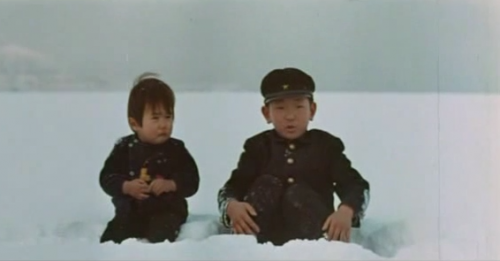
A child (Tetsuo Abe) seeks a better way of life in postwar Japan in Nagisa Oshima’s BOY
BOY (SHONEN) (Nagisa Oshima, 1969)
BAMcinématek, BAM Rose Cinemas
30 Lafayette Ave. between Ashland Pl. & St. Felix St.
Friday, March 25, 2:00, 4:30, 7:00, 9:15
Series runs through March 31
718-636-4100
www.bam.org
 Controversial outlaw filmmaker Nagisa Oshima takes a unique, poignant look at the continuing problems in postwar Japan in the underseen 1969 drama Boy. After a major search for an actor to play the nameless title character, Oshima found Tetsuo Abe in an orphanage, and the young boy delivered one of the most memorable performances ever by a child. Inspired by actual events, the film follows wounded war veteran Takeo Omura (Fumio Watanabe), his second, common-law wife, Takeko Taniguchi (Akiko Koyama), their baby (Tsuyoshi Kinoshita), and Omura’s son from his previous marriage, played by Abe and referred to only as “kiddo.” The family travels across Japan, surviving by means of a classic con: First the stepmother, then the boy pretend to be hit by cars so they can extort money from the drivers. Meanwhile, the boy creates an alternate fantasy life that he shares with his baby brother, involving aliens and monsters, the only time he gets to be like a real kid. Otherwise, he is often by himself, never going to school, wandering lonely through the snow or walking down an empty path on one side of the screen as children play boisterously on the other side. As the authorities close in on the family, tragedy awaits.
Controversial outlaw filmmaker Nagisa Oshima takes a unique, poignant look at the continuing problems in postwar Japan in the underseen 1969 drama Boy. After a major search for an actor to play the nameless title character, Oshima found Tetsuo Abe in an orphanage, and the young boy delivered one of the most memorable performances ever by a child. Inspired by actual events, the film follows wounded war veteran Takeo Omura (Fumio Watanabe), his second, common-law wife, Takeko Taniguchi (Akiko Koyama), their baby (Tsuyoshi Kinoshita), and Omura’s son from his previous marriage, played by Abe and referred to only as “kiddo.” The family travels across Japan, surviving by means of a classic con: First the stepmother, then the boy pretend to be hit by cars so they can extort money from the drivers. Meanwhile, the boy creates an alternate fantasy life that he shares with his baby brother, involving aliens and monsters, the only time he gets to be like a real kid. Otherwise, he is often by himself, never going to school, wandering lonely through the snow or walking down an empty path on one side of the screen as children play boisterously on the other side. As the authorities close in on the family, tragedy awaits.

Nameless brothers (Tsuyoshi Kinoshita and Tetsuo Abe) experience troublesome circumstances in BOY
Best known for radical, cutting-edge films filled with violence and sexuality, including Cruel Story of Youth, The Pleasures of the Flesh, In the Realm of the Senses, and Taboo — as well as Max, Mon Amour, in which Charlotte Rampling plays a diplomat’s wife who falls in love with a chimpanzee — Oshima shows a warm, gentle touch in Boy, led by a tender lead performance by Abe, who is often shown standing firmly, dressed in a uniformlike outfit, like a little soldier. Oshima and cinematographers Yasuhiro Yoshioka and Seizo Sengen bathe the film in bursts of yellow, blue, and red, setting the bright colors against an essentially black-and-white palette that turns a haunting blue and then sepia near the end, accompanied by Hikaru Hayashi’s evocative, wide-ranging score. Hovering around the tale, which serves as a parable for the many troubles families experienced after World War II and is perhaps most reminiscent of François Truffaut’s nouvelle vague standard-bearer, The 400 Blows, is the Japanese flag; the father and the baby wave a small one in their hands, the family stops underneath one when figuring out their next move, and a large one taunts them on a back wall as the father berates the stepmother in a hotel room. Through it all, the boy remains steadfast. “I’m a cosmic messenger of justice,” he declares to his baby brother. Boy turned out to be Abe’s only film, as he returned to the orphanage after it was finished. Boy is screening on March 25 in the BAMcinématek series “From the Third Eye: The Evergreen Review on Film,” celebrating the release of From the Third Eye: The Evergreen Review Film Reader, a collection of writings from the influential counterculture magazine headed by Grove Press publisher Barney Rosset. The series, which continues through March 31 with such other films as Alain Robbe-Grillet’s The Man Who Lies, Dennis Hopper’s The Last Movie, and Dick Fontaine’s Will the Real Norman Mailer Please Stand Up?, is curated by critic Ed Halter, who edited the book with Rosset, who passed away in 2012 at the age of eighty-nine.